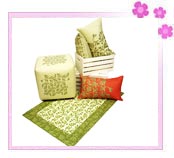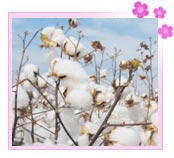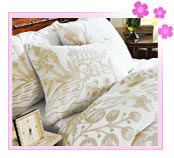What is an Eco Friendly Concept?
The term eco friendly or environmentally friendly or nature friendly in the home textile industry refers to the no use of pesticides, chemicals and fertilizers while growing the fiber plants and also no use of harmful chemicals while processing and dyeing the fibers into fabrics for home textile products. Apart from these, maintenance, storage and recycling techniques are also considered.
 Normally in the growing process many fertilizers, insecticides and
pesticides are used. Like for producing cotton, about 25% of the whole
insecticides are utilized, which is a daunting number in itself. Apart from
this, machine picking of cotton needs growth regulators, harvest aid
chemicals and herbicides. Cotton also pollutes the air while spinning. In
spinning small cotton fibers float in the air which are harmful if inhaled.
To strength the cotton, the process of sizing is done in which many harmful
chemicals like pentachlorophenol are used with starch. This specific
chemical has harmful effects on human skin. Again in dyeing with azo dyes
and carcinogenic amines many hazardous effects have been noticed.
Normally in the growing process many fertilizers, insecticides and
pesticides are used. Like for producing cotton, about 25% of the whole
insecticides are utilized, which is a daunting number in itself. Apart from
this, machine picking of cotton needs growth regulators, harvest aid
chemicals and herbicides. Cotton also pollutes the air while spinning. In
spinning small cotton fibers float in the air which are harmful if inhaled.
To strength the cotton, the process of sizing is done in which many harmful
chemicals like pentachlorophenol are used with starch. This specific
chemical has harmful effects on human skin. Again in dyeing with azo dyes
and carcinogenic amines many hazardous effects have been noticed. But if we talk about eco friendly textiles for our home then while making eco friendly fabrics these harsh chemicals are not used. Like to grow environmentally friendly cotton no harsh chemical at any stage is used. This makes environmentally friendly cotton fabric, which is then extensively used for making other textile related items. To further enhance the concept of eco friendly textiles, these home textiles products of bed & bedding furnishings, bathroom furnishings etc are kept unbleached and un-dyed.
Which are the Different Eco Friendly Fabrics?
Eco friendly fabrics are harmless and available at much lower cost than their synthetic counterparts. Most common eco friendly fabrics are
|
|
|
 To make eco friendly home textiles of cotton, the cotton seeds are untreated
with no use of GMO/BT. Soil and water are conserve by using manure instead
of fertilizers and doing crop rotation. Furthermore weeds are also removed
by hand instead of harmful herbicides. Weeds are also controlled by using
machines which again are harmless. Pest control in eco friendly fabrics is
done with the help of natural predators and for harvesting natural
defoliation instead of toxic chemicals is done. By following these processes
eco-friendly cotton is produced that is safe to the environment and human.
To make eco friendly home textiles of cotton, the cotton seeds are untreated
with no use of GMO/BT. Soil and water are conserve by using manure instead
of fertilizers and doing crop rotation. Furthermore weeds are also removed
by hand instead of harmful herbicides. Weeds are also controlled by using
machines which again are harmless. Pest control in eco friendly fabrics is
done with the help of natural predators and for harvesting natural
defoliation instead of toxic chemicals is done. By following these processes
eco-friendly cotton is produced that is safe to the environment and human. There are many small, big, national and international companies that are into eco friendly textile industry. TIC Bamboo Fabrics is famous for producing green home textiles made up from bamboo. In2Green LLC has its name for producing recycled and eco friendly yarn. Whereas if you are looking for yarns and fabrics made with certified organic wool then check the Vermont Organic Fiber Co. Along with this there are many other companies like Green Textiles, FiberCo Inc, Oasis Enterprises, Fiber Organics, Aurora Silks that make eco friendly yarn, environmentally friendly fibers and green home textiles.
Increase in the Use of Eco Friendly Dyes for Coloring the Home Textiles
 To dye the non organic home textiles and even the organic ones many heavy
and noxious chemicals are used. But now there are msany eco friendly dyes
that have replaced these harmful chemicals. Recently going with the idea of
eco friendly is on trend in home textile, the German legislation has
announced an ordinance that states “No articles of dresses (textiles,
shoes, leather) and bed linen can be put in trade, if they have been colored
with azo dyes that can release one of the twenty named amines". Eco
friendly dyes include dyes made from vegetables and low impact dyes with no
toxics.
To dye the non organic home textiles and even the organic ones many heavy
and noxious chemicals are used. But now there are msany eco friendly dyes
that have replaced these harmful chemicals. Recently going with the idea of
eco friendly is on trend in home textile, the German legislation has
announced an ordinance that states “No articles of dresses (textiles,
shoes, leather) and bed linen can be put in trade, if they have been colored
with azo dyes that can release one of the twenty named amines". Eco
friendly dyes include dyes made from vegetables and low impact dyes with no
toxics. Environmentally Friendly Chemicals in Home Textile
The demand for environmentally friendly chemicals have altered the whole scenario of textile industry. Textile manufacturers & suppliers are demand for these eco friendly chemicals to make the organic textile. The demand for environmentally friendly chemicals has increased to 2.8% and expected to reach at $19 billion by 2012. India and China are the biggest consumer of these textile chemicals.
Different Trade Marks in Environmentally Friendly Textile Industry
With the increase in eco friendly fabrics, there has been seen rise in the various trade marks for these environmentally friendly home textiles. Consumers are getting aware of these labels and check these before buying their products like bed spreads, bed sheets, organic kitchen towels and other bathroom furnishings or other home textile products.
The increase in the number of labels shows the growth in the consciousness towards green home textile concept. The eco-labels are most commonly issued by the enterprises that are either supported by the government or run privately. Here the complete life cycle of the product is taken into account and the final product is checked for pesticides used during growth, chemical while processing and dyeing. Also the distribution and maintenance is taken into account.
- EU Eco-labels: These eco-labels are valid in 15 countries.
- MUT: Any green home textile that is made from environmentally sound protection methods (VVUT) will have MUT trademark. While manufacturing of these environmentally friendly textiles acceptance to certain pre-specified rules is required.
- GUT: GUT stands for Gemeinschaft Umweltfreundlicher Teppichboden and an eco-friendly trademark for the carpet companies in Europe. Gemeinschaft Umweltfreundlicher Teppichboden is an association for environmentally friendly carpets.
- GuW: Eco-friendly Furnishing Fabric Association gives their seal under Gu
- CLEAN FASHION: CLEAN FASHION, which is an eco friendly label was developed by private companies that are related to home textiles.
- GREEN COTTON: A label based on an internal evaluation system that considers social, ecological and toxicological values.
- ECO MARK: ECOMARK is an eco-label that is in India.
Different Eco Friendly Labels in Home Textiles
- MST (Markenzeichen Schadstoffgeprufter Textile)
This lable is used for the products made in Germany stating the properties of textile. - OEKO- TEX Standard 100
This standard has different product classes. Like Product class I, II, III & IV. The Product Class III includes textiles that are not in direct contact with skin & Product Class IV are the home furnishing textiles used for home decor. The standards are given by the Austrian Textile Research Institute and the German "Hohenstein Research Institute" - (GOTS) Global Organic Textile Standard
In this standard the production, precessing, manufacturing, packaging, labeling, exportation, importation and distribution of natural fibers are considered. Once all the parameters are met the product is given the GOTS standard.
Organic textile industry in India has enormous scope as the consumer now becoming health and environment conscious. According to the estimates the global retail sales for the year 2008 has grown to $2.6 billion. This shows the growth of 116% in the average annual growth rate. India is the largest producer of organic cotton and thus cotton based home textiles that are natural and environmentally friendly. Whereas Europe is the largest grower of quality hemp. So with all these it can be said that eco friendly is on trend in home textile industry.



